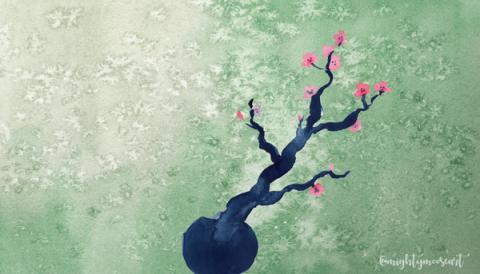
It’s hard to deny, as lilacs bust out, that stuffing a handful of fragrant flowers in a vase is super-springtime-satisfying. I’m a sucker for a fistful of lily of the valley, myself. But, as spring blossoms into summer and flowers flash unique colors and shapes, why not consider a more simplistic and intentional arrangement? Why not try your hand at ikebana, the ancient Japanese art of flower arrangement?
“Ikebana” is made up of two words: the first, “ike,” meaning “alive” or “arrange,” and the second, “bana,” meaning “flower.” Ikebana, boiled down, is live flower arranging, but it is much more than gathering a collection of flowers for decoration. The practice of ikebana is as spiritual in process as it is practical.
Sofu Teshigahara, who founded the Sogetsu School of Ikebana in 1927, describes the creative art of ikebana in saying:
“Ikebana is not just about sticking a flower into a vase: it is about the love and need of the artist to create beautiful forms…ikebana is not just about flowers, it is about the person who arranges them.”
Teshigahara reminds his students and those practicing ikebana that anyone can do ikebana anywhere with anything. An ikebana arrangement can be placed in any space: on a table, entryway, windowsill, counter, in a banquet hall, shop window, public space, etc. Any space is appropriate for ikebana because the art of flower arranging brings nature – the living environment – into spaces of the modern world, which can sometimes be void of organic features that have been replaced with those artificial.
Overall, ikebana is an art form. It is means of expression in the same way that painting and sculpture is regarded as a contemplative work of creativity and commentary. The high regard for ikebana as a spiritual art form is derived from the Japanese love of nature. Shinrin-Yoku forest medicine is a prime example of how the Japanese recognize and cherish nature as a sacred, healing space. Ikebana, in fact, is like its own type of medicine for the mentale; this ancient art of flower arranging is a way to bring nature – the exterior world – indoors, in an effort to inspire and move. Ikebana is a powerful and meditative process that is meant to bridge the gap between indoors and outdoors.
Ikebana is meant to be done in silence.
While one is creating ikebana, holding a silent space allows for one to meditate on the beauty of nature and the consequent symbolic relationship fostered by bringing that nature indoors with intention.
Ikebana is meant to be done in space.
Figuratively speaking, space is created by inviting silence into the practice of ikebana. Literally speaking, space is valued in the understanding that all spaces must not be filled, and that space may thus be created as a result.
Ikebana embodies minimalism, balance and graceful aesthetics.
Following, ikebana is not meant to be complicated. In ikebana, if you will, less is often more. According to ikebana, a single, flowerless branch, for example, can offer a natural elegance that fifteen full-bloom flowers cannot. Simplicity and balance are paramount in creating ikebana…and simplicity can sometimes be challenging in an increasingly materialistic world. This is why ikebana is a treasured spiritual practice of meditative mindfulness. Practicing ikebana is thought to bring one peace of mind.
Make Your Own Ikebana
You will need:
- Utsuwa, a shallow container, bowl, or vessel (I use a nice clay bowl or deep plate)
- Kenzan, basically a floral frog
- Scissors (floral, if you have them)
- Natural elements: floral cuttings, branches, vines, leaves, etc. – be creative here!
Key elements of design:
- The three essential parts of moribana ikebana (classic ikebana expression) arrangements are cuttings of a given height based on the size of the utsuwa, or container. Add the width and height of the utsuwa to determine the proper measurement of the pieces in the arrangement. For example, if the utsuwa sits 2 inches tall and four inches wide, six inches would be the baseline from which to work.
- Then, measure and cut the three pieces of the arrangement according to this:
- Shin, representing heaven – a height of 1.5-3 times the baseline (For ease, I generally default to making shin 2x the baseline. Based on the example, this would be 12 inches tall.)
- Soe, representing man – a height of approximately 2/3 of shin
- Tai, representing earth – a height of approximately 2/3 of soe
In this sense, the arrangement builds off of itself, from base upward.
Beyond the key elements of design, more masterful ikebana practitioners arrange the basic design – with shin, soe, and tai – to fill a three-dimensional space. This can be more challenging, but starting with vertical angling (right-left) is much easier for most than horizontal (front-back). The corresponding angles for each of the three key elements are:
- Shin (heaven) – 10 degrees to the right or left, and 10 degrees to the front
- Soe (man) – 40 degrees to the right or left, and 40 degrees to the front
- Tai (earth) – 70 degrees to the right or left, and 70 degrees to the front
(If you’re a visual learner, like me, check out this fabulous site with helpful diagrams!)
Ikebana can be (as most arts can) a lifelong study. Ikebana can also be a mindful hobby and personal pleasure. I find that when I set out to make an ikebana arrangement, I ponder more intentionally and creatively what I select from the garden (flower or vegetable!), the forest, or the backyard lawn. Ikebana, in this way, is a type of meditation on the beauty of nature. Where are you capable of seeing beauty? In a dry poppy pod? In the shape of the leaves on a weed? You may surprise yourself…








